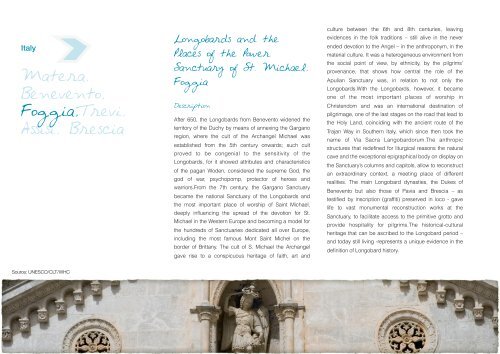EUHeritageTOUR-TourGuide-Basic-EN
EUHeritageTOUR-TourGuide-Basic-EN
EUHeritageTOUR-TourGuide-Basic-EN
Create successful ePaper yourself
Turn your PDF publications into a flip-book with our unique Google optimized e-Paper software.
Italy<br />
Matera,<br />
Benevento,<br />
Foggia,Trevi,<br />
Assisi, Brescia<br />
Longobards and the<br />
Places of the Power.<br />
Sanctuary of St. Michael,<br />
Foggia<br />
Description<br />
After 650, the Longobards from Benevento widened the<br />
territory of the Duchy by means of annexing the Gargano<br />
region, where the cult of the Archangel Michael was<br />
established from the 5th century onwards; such cult<br />
proved to be congenial to the sensitivity of the<br />
Longobards, for it showed attributes and characteristics<br />
of the pagan Woden, considered the supreme God, the<br />
god of war, psychopomp, protector of heroes and<br />
warriors.From the 7th century, the Gargano Sanctuary<br />
became the national Sanctuary of the Longobards and<br />
the most important place of worship of Saint Michael,<br />
deeply influencing the spread of the devotion for St.<br />
Michael in the Western Europe and becoming a model for<br />
the hundreds of Sanctuaries dedicated all over Europe,<br />
including the most famous Mont Saint Michel on the<br />
border of Brittany. The cult of S. Michael the Archangel<br />
gave rise to a conspicuous heritage of faith, art and<br />
culture between the 6th and 8th centuries, leaving<br />
evidences in the folk traditions – still alive in the never<br />
ended devotion to the Angel – in the anthroponym, in the<br />
material culture. It was a heterogeneous environment from<br />
the social point of view, by ethnicity, by the pilgrims’<br />
provenance, that shows how central the role of the<br />
Apulian Sanctuary was, in relation to not only the<br />
Longobards.With the Longobards, however, it became<br />
one of the most important places of worship in<br />
Christendom and was an international destination of<br />
pilgrimage, one of the last stages on the road that lead to<br />
the Holy Land, coinciding with the ancient route of the<br />
Trajan Way in Southern Italy, which since then took the<br />
name of Via Sacra Langobardorum.The anthropic<br />
structures that redefined for liturgical reasons the natural<br />
cave and the exceptional epigraphical body on display on<br />
the Sanctuary’s columns and capitols, allow to reconstruct<br />
an extraordinary context, a meeting place of different<br />
realities. The main Longobard dynasties, the Dukes of<br />
Benevento but also those of Pavia and Brescia – as<br />
testified by inscription (graffiti) preserved in loco - gave<br />
life to vast monumental reconstruction works at the<br />
Sanctuary, to facilitate access to the primitive grotto and<br />
provide hospitality for pilgrims.The historical-cultural<br />
heritage that can be ascribed to the Longobard period –<br />
and today still living -represents a unique evidence in the<br />
definition of Longobard history.<br />
Source: UNESCO/CLT/WHC


